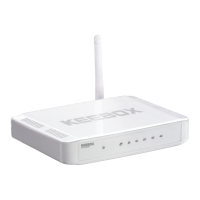KEEBOX Wireless 11n Router
Wireless Tips
The following are some general wireless tips to help minimize the impact of interference within an
environment.
Assign your network a unique SSID. Do not use anything that would be identifying like “Smith Family
Network”. Choose something that you would easily identify when searching for available wireless
networks.
Do not turn off the SSID broadcast. The SSID broadcast is intended to be on and turning it off can cause
connectivity issues. The preferred method of securing a wireless network is to choose a strong form of
encryption with a strong and varied encryption key.
Note: after setting up the SSID, encryption type and encryption key/passphrase, please make a note of
them for future reference. You will need this information to connect your wireless computers to the
wireless router/access point.
Change the channel. Most wireless access points and routers are defaulted to channel 6. If you have a
site survey tool that will display the channels you can plan your channel selection around neighboring
access points to minimize interference from them. If your site survey tool does not display the channel try
using channels 1 or 11.
If using 802.11n you should be securing the network with WPA2 security.
Note: Due to Wi-Fi certification considerations if you choose WEP, WPA or WPA2-TKIP encryption this
device may operate in legacy wireless mode (802.11b/g). You may not get 802.11n performance as
these forms of encryption are not supported by the 802.11n specification.
Please also make sure that the wireless hardware is not placed in any type of shelving or enclosures.
Avoid stacking hardware on top of each other to prevent overheating issues. Maintain enough free space
around the hardware for good ventilation and airflow. There should also be plenty of free space around
the antennas to allow the wireless signal to propagate.
There are a number of other environmental factors that can impact the range of wireless devices.
1. Adjust your wireless devices so that the signal is traveling in a straight path, rather than at an
angle. The more material the signal has to pass through the more signal you will lose.
2. Keep the number of obstructions to a minimum. Each obstruction can reduce the range of a
wireless device. Position the wireless devices in a manner that will minimize the amount of
obstructions between them.
3. Building materials can have a large impact on your wireless signal. In an indoor environment, try
to position the wireless devices so that the signal passes through less dense material such as
dry wall. Dense materials like metal, solid wood, glass or even furniture may block or
degrade the signal.
4. Antenna orientation can also have a large impact on your wireless signal. Use the wireless
adapter’s site survey tool to determine the best antenna orientation for your wireless devices.
4

